by G. Bhutan, Jan 17, 2022 in Elements
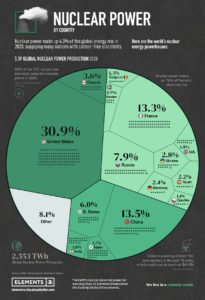
…
…
by N. Moussu, Dec 10, 2021 in Euractiv
During an exchange with French parliamentarians this week, the EU Commission vice-president in charge of the Green Deal, Frans Timmermans, said Brussels “will support, sustain and assist those member states that make this choice” of using nuclear power. EURACTIV France reports.
Timmermans, who was speaking on Wednesday (8 December) to the National Assembly’s committees on European Affairs and Sustainable Development, promised an inclusive and ambitious ecological transition that leaves no one behind.
They discussed the work of the European Commission on various issues related to the ecological transition, ranging from the carbon market to hydrogen, the evolution of the automotive sector, nuclear power in the green taxonomy and the timetable for the Fit for 55 package.
“We know that there will be a lot of negotiating to do [by the European Commission],” said Laurence Maillard Méhaignerie, chair of the French parliament’s Committee on Sustainable Development and Regional Planning.
“It is also a work of conviction, because, in the end, it is the economic models and value chains that need to be reviewed, the lifestyles and jobs that are also profoundly transformed” by the ecological transition.
This ecological transition and the measures that come with it would not only make individuals and companies feel excluded or suffer from the transition, but, as Renew Europe MEP Pascal Canfin warned a few months ago, could also create a new movement like the Gilets jaunes.
But according to Timmermans, “no one will be left behind, abandoned in this transition”.
“We must show through concrete steps (…) that we are concerned about social issues. The transition will be social or it will not be!” he added.
by D. Murtaugh & K. Chia, Nov 2, 2021 in BloombergGreen
China is planning at least 150 new reactors in the next 15 years, more than the rest of the world has built in the past 35.
Nuclear power once seemed like the world’s best hope for a carbon-neutral future. After decades of cost-overruns, public protests and disasters elsewhere, China has emerged as the world’s last great believer, with plans to generate an eye-popping amount of nuclear energy, quickly and at relatively low cost.
China has over the course of the year revealed the extensive scope of its plans for nuclear, an ambition with new resonance given the global energy crisis and the calls for action coming out of the COP26 Climate Summit in Glasgow. The world’s biggest emitter, China’s planning at least 150 new reactors in the next 15 years, more than the rest of the world has built in the past 35. The effort could cost as much as $440 billion; as early as the middle of this decade, the country will surpass the U.S. as the world’s largest generator of nuclear power.
…
by P. Homewood, Feb 23, 2021 in NotaLotofPeopleKnowThat
BELGIUM’s decision to shut down several of its nuclear power plants has been branded “delusional” and pinned on the EU’s plot to annihilate member states’ independence.
Belgium will shut seven nuclear power plants between 2022 and 2025. The decision was confirmed at the end of 2020 by Alexander De Croo’s coalition government. But the plan would see the country reliant on its neighbours for the supply of electricity – something that was blamed on the increasing integration of the European Union.
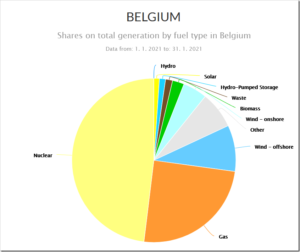
http://energodock.com/belgium/electricity-shares
by Connaissance des Energies, Dec 1, 2020
En Belgique, l’exploitant du parc nucléaire Electrabel a annoncé en interne son intention de cesser les investissements nécessaires à la prolongation (hypothétique) de réacteurs. Il est prévu que les derniers réacteurs nucléaires du pays soient arrêtés d’ici à fin 2025 sauf si…
Combien y a-t-il de réacteurs nucléaires en service en Belgique ?
Le parc nucléaire belge est composé de 7 réacteurs à eau pressurisée tous exploités par Electrabel, filiale du groupe français Engie(1). Connectés au réseau électrique entre 1974 et 1985, ces réacteurs sont répartis entre 2 centrales :
- la centrale de Doel en Flandre (à 15 km du port d’Anvers et près de la frontière néerlandaise), composée de 4 réacteurs d’une puissance cumulée de 2 934 MW ;
- la centrale de Tihange en Wallonie (à 30 km de Liège), composée de 3 réacteurs d’une puissance cumulée de 3 008 MW.
En 2019, le parc nucléaire belge a généré près de 41,4 TWh, soit environ 46,5% de la production électrique totale du pays(2). « Sur base d’une analyse temporelle plus étendue, on observe que la contribution du nucléaire à la consommation finale d’électricité varie selon les année entre grosso modo 35%(3) et 50% selon la disponibilité des unités », précise Michel Huart, maître de conférences à l’ULB, spécialiste en « énergie et durabilité ».
Vue de la centrale nucléaire de Doel. (©Electrabel)
…
by World Nuclear News, Sep 10, 2020
A new research project supported by the European Union aims to clarify, enhance and unify methods of structural integrity assessment of safety-critical concrete infrastructure in support of long-term operation of nuclear power plants. Coordinated by Finland’s VTT Technical Research Centre, the collaborative project seeks to improve the understanding of ageing and deterioration of such concrete.
…
In September 2018, Belgian utility Electrabel announced that scheduled outages at Tihange 2 and 3 had been extended while concrete degradation issues in adjacent non-nuclear buildings were addressed (Image: Electrabel)
The ACES project, which began on 1 September and will run until 31 August 2024, has a total budget of just over EUR5 million (USD6 million), of which the European Commission is funding almost EUR4 million under the H2020-Euratom-1 programme.
The consortium involved in the project comprises 10 European companies and research partners, and one international partner. They are: Engie Lab and SCK-CEN of Belgium; CTU and CVR of the Czech Republic; CEA, EDF and IRSN of France; ZAG of Slovenia; Energorisk of Ukraine; and, ORNL of the USA.
The project will study the deterioration and ageing mechanisms of reinforced concrete, such as in reactor containment buildings, as well as predicting the occurrence of corrosion. It aims to develop an innovative inspection tool for early detection of corrosion.
…
by World Nuclear News, September 1, 2020
The US Nuclear Regulatory Commission (NRC) has issued a final safety evaluation report (FSER) for NuScale’s small modular reactor. This is the first-ever FSER to be issued by the NRC for an SMR, and represents the completion of the technical review and approval of the design.
NuScale’s application for certification of its SMR design for use in the USA was submitted on 31 December, 2016 and was accepted by the NRC the following March. NRC said its completion of the technical review within its original 42-month schedule demonstrates its commitment to “timely” licensing of new, advanced reactor technology.
“This is a significant milestone not only for NuScale, but also for the entire US nuclear sector and the other advanced nuclear technologies that will follow. This clearly establishes the leadership of NuScale and the US in the race to bring SMRs to market,” said NuScale Chairman and CEO John Hopkins. He also credited strong bipartisan support from US Congress for the project, which received cost-shared federal funding as it advanced through the NRC Design Certification process.
NuScale said it had spent over USD500 million, with the backing of its majority investor Fluor, and over 2 million labour hours to develop the information needed to prepare its design certification application. The company also submitted 14 separate Topical Reports in addition to the application – itself over 12,000 pages long – and provided more than 2 million pages of supporting information for NRC audits.
The NuScale design uses passive processes such as convection and gravity in its operating systems and safety features to produce about 600 MW of electricity. Twelve modules, each producing 50 MW, are submerged in a safety-related pool built below ground level. The NRC has concluded the design’s passive features “will ensure the nuclear power plant would shut down safely and remain safe under emergency conditions, if necessary”, it said. NuScale has also indicated to NRC it will apply for standard design approval of a version using 60 MW modules, the regulator said. This would require additional NRC review.
Continuer la lecture de NuScale SMR receives US design certification approval
by World Nuclear News, September 1, 2020
The US Nuclear Regulatory Commission (NRC) has issued a final safety evaluation report (FSER) for NuScale’s small modular reactor. This is the first-ever FSER to be issued by the NRC for an SMR, and represents the completion of the technical review and approval of the design.
…
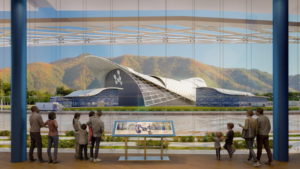
….
The NuScale design uses passive processes such as convection and gravity in its operating systems and safety features to produce about 600 MW of electricity. Twelve modules, each producing 50 MW, are submerged in a safety-related pool built below ground level. The NRC has concluded the design’s passive features “will ensure the nuclear power plant would shut down safely and remain safe under emergency conditions, if necessary”, it said. NuScale has also indicated to NRC it will apply for standard design approval of a version using 60 MW modules, the regulator said. This would require additional NRC review.
…
by Furfari S. & Mund E., 31 janvier 2020 in ScienceClimatEnergie
Les plus chauds partisans de l’énergie nucléaire sont convaincus que la technologie actuelle des réacteurs à eau légère sous pression (PWR) est loin d’être parfaite. Mais elle dispose d’énormes qualités qui rendent son utilisation indispensable. Au nombre de celles-ci, principalement une absence d’émission de CO2 [1] la sécurité d’approvisionnement au sens où la production d’électricité et de chaleur peut satisfaire la demande à tout instant, hormis bien sûr les périodes de maintenance des installations et les pannes éventuelles, et la rentabilité économique au sens où les importants investissements en capitaux peuvent être amortis en des temps beaucoup plus courts que la durée de vie fonctionnelle de ces installations, etc… Dernière qualité, moins évidente pour les non-initiés : la mise en œuvre de la technologie PWR peut revêtir des formes très variées dont certaines (les SMR, petits réacteurs modulaires) renforcent la sûreté déjà très élevée du nucléaire actuel, considérée néanmoins comme insuffisante par les opposants.
…
by l’EnerGeek, 3 décembre 2019
Lundi 2 décembre, la COP25 s’ouvre dans un climat tendu à Madrid. Le 28 novembre dernier, le Parlement Européen a décrété l’urgence climatique. Le Parlement appelle la COP25 à “prendre des mesures audacieuses et ambitieuses”. Et la plus ambitieuse de toutes pourrait être une résolution votée en faveur de l’énergie nucléaire. Car avec la mise en place d’un nouveau mix électrique mondial, cette énergie bas carbone est plus que jamais en bonne position pour devenir le moteur de la transition énergétique.
Le Parlement Européen soutient le nucléaire
Le texte du Parlement Européen revient sur l’importance de l’énergie nucléaire dans le cadre de la transition énergétique et estime que “l’énergie nucléaire peut jouer un rôle dans la réalisation des objectifs climatiques, car elle n’émet pas de gaz à effet de serre et peut également assurer une part significative de la production d’électricité en Europe ; considère néanmoins que, en raison des déchets qu’elle génère, cette énergie nécessite une stratégie à moyen et long terme prenant en compte les avancées technologiques (laser, fusion, etc.) visant à améliorer la durabilité de l’ensemble du secteur”
Valérie Faudon, de la Société Française d’énergie nucléaire (SFEN), François Momboisse, Tristan Kamin et autres experts, consultants ou ingénieurs se sont félicités sur les réseaux sociaux de cette prise de position estimant que le nucléaire est “une solution efficace pour lutter contre le réchauffement climatique, aux côtés des autres énergies bas carbone.” A l’inverse, Michèle Rivasi, députée européenne, a par exemple expliqué par le biais d’un tweet pourquoi elle a voté contre cette résolution :
…

by Roger Pielke, Sep. 30, 2019 in WUWT
I research and write about science, policy and politics.
More than a decade ago, Gwyn Prins and Steve Rayner characterized climate policy as an “auction of promises” in which politicians “vied to outbid each other with proposed emissions targets that were simply not achievable.” For instance, among Democrats competing for the presidency in 2020, several, including Joe Biden, have committed to achieving net-zero carbon dioxide emissions by 2050. Candidate Andrew Yang bid 2049, and Cory Booker topped that by offering 2045. Bernie Sanders has offered a 71% reduction by 2030.
One reason that we see this “auction of promises” is that the targets and timetables for emissions reductions are easy to state but difficult to comprehend. Here I’ll present what net-zero carbon dioxide emissions for 2050 actually means in terms of the rate of deployment of carbon-free energy and the coincident decommissioning of fossil fuel infrastructure.
To conduct this analysis I use the BP Statistical Review of World Energy, which presents data on global and national fossil fuel consumption in units called “million tons of oil equivalent” or mtoe. In 2018 the world consumed 11,743 mtoe in the form of coal, natural gas and petroleum. The combustion of these fossil fuels resulted in 33.7 billion tonnes of carbon dioxide emissions. In order for those emissions to reach net-zero, we will have to replace about 12,000 mtoe of energy consumption expected for 2019. (I ignore so-called negative emissions technologies, which do not presently exist at scale.)
Another useful number to know is that there are 11,051 days left until January 1, 2050. To achieve net-zero carbon dioxide emissions globally by 2050 thus requires the deployment of >1 mtoe of carbon-free energy consumption (~12,000 mtoe/11,051 days) every day, starting tomorrow and continuing for the next 30+ years. Achieving net-zero also requires the corresponding equivalent decommissioning of more than 1 mtoe of energy consumption from fossil fuels every single day.
Another important number to consider is the expected increase in energy consumption in coming decades. The International Energy Agency currently projects that global energy consumption will increase by about 1.25% per year to 2040. That rate of increase in energy consumption would mean that the world will require another ~5,800 mtoe of energy consumption by 2050, or about another 0.5 of an mtoe per day to 2050. That brings the total needed deployment level to achieve net-zero emissions to about 1.6 mtoe per day to 2050.
…
The scale of the challenge to achieve net-zero carbon dioxide emissions in 2050. Roger Pielke Jr., BP 2018
…
by Prof. Ernest Mund, 25 juin 2019 in ScienceClimatEnergie
A la façon dont vont les choses il paraît de plus en plus certain que la Belgique mettra la clé sous le paillasson de son parc de centrales nucléaires en 2025, conformément à la décision de la loi Deleuze votée en 2003. Cet abandon très néfaste est la conséquence du manque de discernement de la part des Autorités politiques au pouvoir face à l’hostilité irréductible du mouvement écologiste à l’égard du nucléaire.
Que cet abandon soit très néfaste est argumenté avec énormément de détails dans un rapport récent de l’IEA (Agence Internationale de l’Energie) dont plusieurs éléments chiffrés sont utilisés dans cette note [1]. Ce rapport analyse avec grande acuité le déclin du nucléaire en service, conçu au cours des années 70. A cette époque le système électrique était centralisé avec une intégration verticale de ses différentes composantes et le prix de l’électricité était le reflet des coûts, indépendamment de toute considération relative à une logique de marché. La taille des installations visait à la réduction des coûts par effet d’échelle. Ce nucléaire (de Génération-II et -III) est devenu totalement inadapté au système décentralisé actuel, alimenté pour une part rapidement croissante en sources d’énergie renouvelable intermittentes (EnRI, éolien et solaire) avec un prix de l’électricité relevant d’un marché, institué dans le courant des années 90.
…
by Connaissance des Energies, 29 avril 2019
À RETENIR
- Les Small Modular Reactors (SMR) sont de petits réacteurs nucléaires réalisés en usines sous forme de modules.
- Leur puissance varie généralement entre 10 et 300 MW.
- Le déploiement des SMR est envisagé pour produire de l’électricité, en particulier dans des sites isolés, mais également pour des applications non électrogènes : chaleur, dessalement, production d’hydrogène, propulsion, etc.
- Fin 2018, on dénombre une cinquantaine de projets de SMR, avec de nombreuses technologies à l’étude.
…
Les modules SMR » de NuScale Power pèseront près de 700 tonnes et pourront être transportés par camion ou par barge. (Image provided by NuScale Power, LLC)
by J.S. Goldstein et al., April 6, 2019
As young people rightly demand real solutions to climate change, the question is not what to do — eliminate fossil fuels by 2050 — but how. Beyond decarbonizing today’s electric grid, we must use clean electricity to replace fossil fuels in transportation, industry and heating. We must provide for the fast-growing energy needs of poorer countries and extend the grid to a billion people who now lack electricity. And still more electricity will be needed to remove excess carbon dioxide from the atmosphere by midcentury.
…
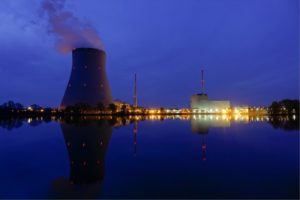
by C. Stam & A. Prager, April 3, 2019 in EurActiv
The text voted in Parliament also excludes fossil fuels and gas infrastructure from the EU’s proposed green finance taxonomy, which aims to divert investments away from polluting industries into clean technologies.
In a bid to prevent “green-washing”, the Parliament text also requires investors to disclose whether their financial products have sustainability objectives, and if they do, whether the product is consistent with the EU’s green assets classification, or taxonomy.
While activists applauded the move, they said the classification voted by the European Parliament was too narrow and applies only to a limited set of recognisable green assets, such as wind and solar power companies.
“Brown list” rejected
An amendment to publish a “brown list” to name and shame investments seen as damaging for the environment was rejected by Parliament.
…
by Prof. Ch. Leclercq-Willain, 5 avril 2019 in ScienceClimatEnergie
Depuis plusieurs années un des combats mené par les écologistes dans différents pays européens (Allemagne, France, Belgique, ..) fut et reste celui du nucléaire mené actuellement en parallèle avec celui de la réduction des gaz à effet de serre (GES). Les « verts » allemands ont obtenu la fermeture de presque toutes les centrales nucléaires et l’Allemagne a toujours une exploitation importante de centrales gaz-charbon. L’Allemagne est ainsi le plus grand émetteur de CO2 en Europe. Il en est de même des pays de l’Est et de la Russie qui exploitent essentiellement des centrales gaz-charbon. En Belgique, la fermeture définitive des centrales nucléaires est prévue pour 2025.
…
by Bloomberg, April 2, 2019 in SouthChinaMorningPost
China’s home-grown nuclear technology is gaining favour in the battle for the nation’s next generation of reactors, according to a state-owned developer, as it sought to recover from delays and cost blowouts from imported designs.
China’s reactor, known as the Hualong One, will be faster and easier to repair and maintain than competing foreign designs because it will be made at home, according to Chen Hua, chief executive officer of China National Nuclear Power company (CNNP), which builds and operates nuclear power projects.
“We prefer the Hualong One,” Chen said on Monday at a nuclear energy conference in Beijing.
The global nuclear industry has been awaiting a revival in China after cost overruns and stricter regulation after the 2011 Fukushima disaster in Japan stalled the approval and construction of more units.
…
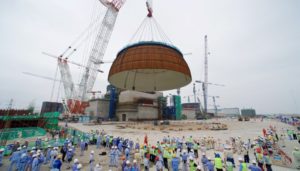
by Stop These Things, November 20, 2108 in ClimateChangeDispatch
In the climate alarmists’ worldwide crusade against carbon dioxide gas, only the most delusional still believe that wind and solar power add anything to their arsenal.
As we have said repeatedly, nuclear power is the only stand-alone power generation source which is capable of delivering power on demand, without CO2 emissions being generated in the process.
Perversely, notwithstanding that Australia is in the top three uranium exporters, it’s the only G20 country with a legislated prohibition on nuclear power generation…
by GlobalData Energy, October23, 2018
Nuclear technology is a major base-load power-generating source and accounted for 10.5% of global power generation in 2017 as per GlobalData, a leading data and analytics company.
The nuclear power sector is growing in many countries as demand for electricity increases. The company’s latest report ‘Nuclear Power – Thematic Report’ reveals that some 31 countries are currently operating nuclear reactors for their electricity generation. Countries with significant nuclear power capacity are the US, France, Japan, China, Russia, South Korea, Canada, and Ukraine, with more than ten gigawatts (GW) installed capacity each. Germany, the UK, Sweden, India, Spain, Belgium, and Taiwan have five to ten GW installed nuclear power capacity each.
The global cumulative installed nuclear power capacity in 2010 was 376GW, of which more than 100GW was in the US alone.
…